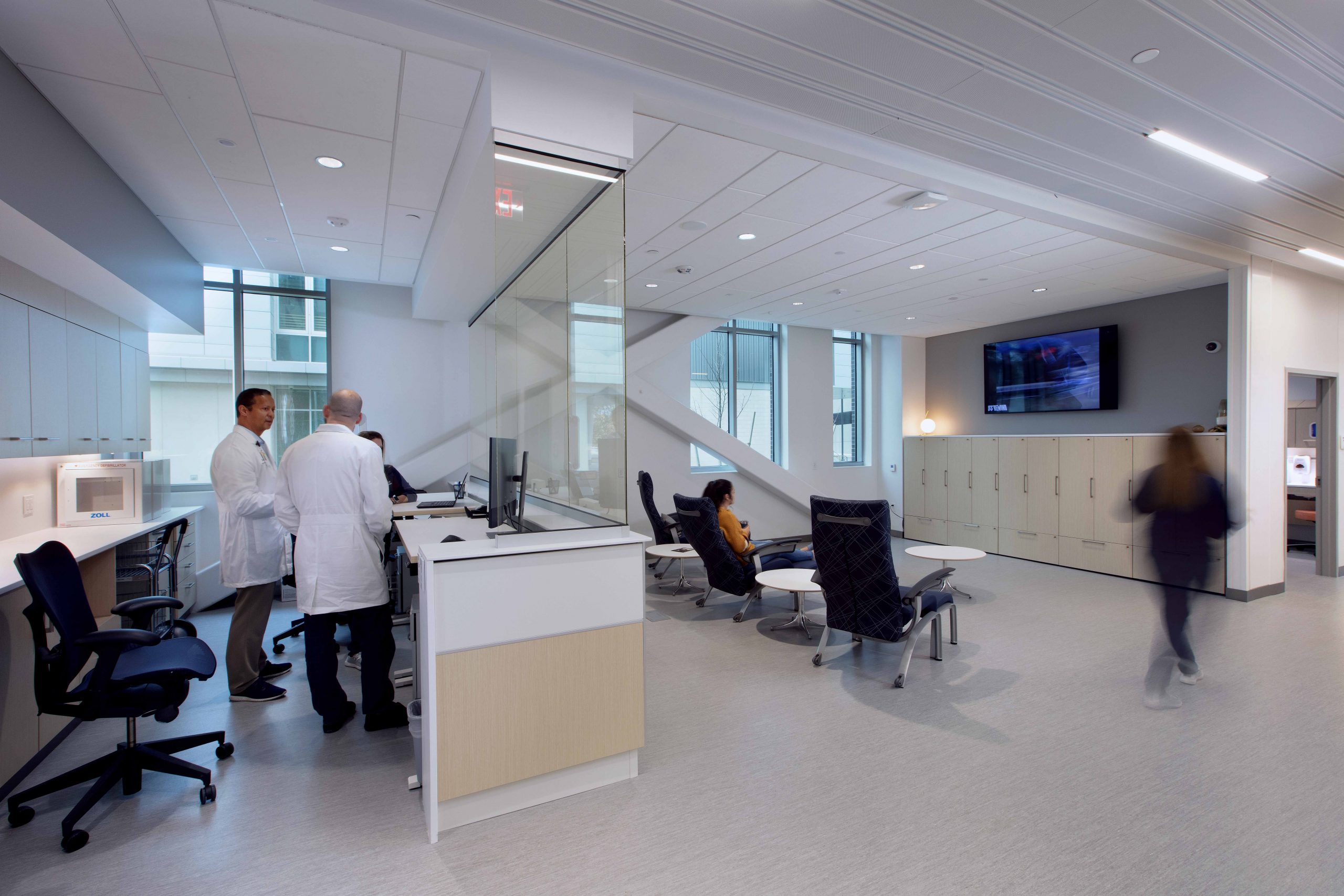The healthcare industry is facing an urgent crisis — there simply aren’t enough caregivers to meet demand. With patient numbers surging and staffing shortages intensifying, hospitals and clinics are struggling to recruit and retain workers. By 2028, experts predict the U.S. will be short 100,000 healthcare professionals, including nearly 80,000 full-time registered nurses. While much attention is given to patient care, we must also ask: Are we designing spaces that support the well-being of the people who provide it?
Although the urgency around workforce challenges has diminished since the peak of the COVID-19 pandemic, healthcare teams still face significant strain. A national survey conducted by the American Nurses Association in April 2024 found that 62% of nurses reported experiencing burnout, leading to exhaustion, feelings of inefficacy and emotional detachment. Recognizing burnout’s impact on staff well-being and patient care, hospitals are rethinking their facilities and programs to better support the mental, emotional and physical health of their teams.
Historically, hospital and healthcare facility design has prioritized patient care while often overlooking the needs of frontline staff. However, investing in caregiver well-being is crucial, leading to fewer accidents, improved staff retention and cost savings for health systems. As older facilities undergo renovations and new ones are built, intentional design choices can enhance recruitment, empower nurses and ultimately improve patient outcomes.
Thoughtful design and construction play a crucial role in shaping a supportive work environment for healthcare staff. Key considerations such as acoustics, lighting, safety, material selection, access to natural light and outdoor spaces and dedicated respite areas are essential for creating a functional, calming and restorative setting.
With extensive experience in health and well-being construction, Rockford collaborates closely with a diverse range of designers to integrate industry best practices into new facility and renovation designs. We partner with design teams at every stage, guiding people-centric design choices that align with client expectations.
Respite Spaces
Spaces dedicated to rest, such as balconies, courtyards, gardens and privacy booths, demonstrate a cultural commitment to staff well-being. However, these areas often go unused due to their distance from high-traffic zones. Instead, industry experts and designers are recommending bringing respite to the healthcare worker by incorporating small restorative spaces within nursing stations, hallways, cafeterias, restrooms and other frequented areas. Design elements such as varied lighting, acoustic treatments, ceiling and wall height adjustments and windows can create moments of calm within high-intensity environments.
Acoustics & Noise Control
Noise in hospitals is inevitable, but managing it is essential. According to OSHA, excessive noise contributes to stress, decreases productivity and hinders communication and concentration. Thoughtful design solutions, such as sliding doors, acoustic ceiling tiles, wall treatments, flooring choices and strategic floor layouts, can reduce noise by up to 35%, benefiting both caregivers and patients while lowering stress levels.
Lighting
Lighting design in healthcare spaces should enhance well-being while maintaining operational efficiency. High-performing, adjustable lighting and increased access to natural light can reduce stress and depression among both staff and patients. A well-lit environment fosters a welcoming atmosphere without compromising functionality.
Daylight & Nature
Humans are naturally drawn to nature, and incorporating outdoor elements into healthcare settings enhances well-being. Design strategies such as large windows, outdoor views, walking paths, healing gardens and nature-inspired artwork create a calming environment. These elements have been shown to reduce anxiety and depression while improving staff satisfaction.
Safety
Workplace safety is critical, particularly in physically demanding roles like nursing. Overexertion from repetitive physical tasks accounts for approximately 45.6% of nurse injuries, which can lead to long-term health issues and mental strain. Thoughtful facility design, such as integrating motorized overhead patient ceiling lifts and optimizing workflow layouts, reduces the risk of injuries, absenteeism and burnout, ensuring a safer and healthier work environment.
As a leading health and well-being facility builder, Rockford is focused on integrating these best practices in facility design into the projects we bring to life for our clients. By helping our clients and their design teams prioritize caregiver well-being elements such as noise reduction, strategic lighting, access to nature and enhanced safety measures, Rockford helps create healing environments that support healthcare staff in meaningful ways. These investments not only improve recruitment and retention but also foster a culture that values and sustains its workforce. In a growing and demanding healthcare landscape, designing and building spaces that nurture both patients and providers alike will be key to building a resilient and effective system.

Caring for the Caregiver: Construction Best Practices




No items found.
Related Posts
The healthcare industry is facing an urgent crisis — there simply aren’t enough caregivers to meet demand. With patient numbers surging and staffing shortages intensifying, hospitals and clinics are struggling to recruit and retain workers. By 2028, expert
Located in one of Detroit’s most historically underserved neighborhoods on Joy Road, the new Covenant Community Care Health Center is reshaping lives through health and well-being services that were previously not accessible. Expected to serve roughly 10,000 community members annually, this new health center signifies an investment in empowering a diverse young community.
Alex Beck has always been a problem solver. Since he was a kid, he loved completing puzzles, taking things apart to see how they worked and putting them back together again. From those curious roots, Beck has come to work at Rockford Construction after beginning his career as a mechanical engineer.
Recent Posts

We Are Rockford
Honoring the legacy and paving the future for growth Rockford refreshes branding for the future.

313 Day: An Introduction to Tim Bryan
As part of 313 Day, we sat down with new Vice President of the Southeast Region Tim Bryan to discuss his construction journey and what he foresees for the future of Detroit.

Women in Construction Week: Team Member Spotlights
Alexandra Livingstone, Anna Warren, Ashley Badder, Sydney Powers and Whitney Kutcher provide advice for future generations of women in construction.







